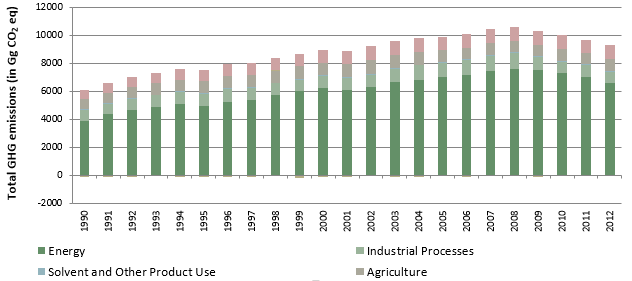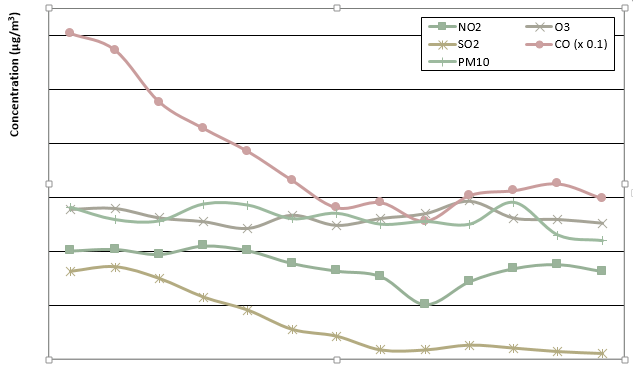Main themes and sectors addressed in the national State of Environment report
The National State of the Environment Report (SoER) is prepared in accordance with the provisions of the Law on public access to environmental information (N. 119(I)/2004) and must include information on the quality of, and the pressures on, the environment. The following environmental themes are covered: atmospheric environment, climate change, water resources, marine and coastal environment, nature and biodiversity, land use, energy, waste, transport, and environmental noise. The indicators are determined on the basis of monitoring data and trend availability for each thematic area. The 2015 SoER is currently under preparation.
Key findings of the State of Environment report
Climate Change
Cyprus is a country already experiencing climate change, especially through extensive droughts and the associated impacts on water supply, biodiversity and other sectors.
According to the latest inventory submitted to the United Nations Framework Convention on Climate Change (UNFCCC) secretariat[1], the total national emissions of the country increased by 52% between 1990 and 2012.[2] Since 2008, however, total emissions have been reducing by an average of 3% annually, primarily due to the financial situation of the country and the impact of the promotion of renewable energy sources (RES) (Figure 1). Energy remains the largest source of emissions (71%) of which 54% is from the production of electricity and 32% is from road transport.

Source: Submission to the United Nations Framework Convention on Climate Change secretariat, 2014
Nature and Biodiversity
Cyprus designated 40 Sites of Community Interest (SCI) and 30 Special Protected Areas (SPA) for their inclusion in the Natura 2000 Network, in order to implement the Habitat Directive 92/43/EC and the Birds Directive 2009/147/EC. Information regarding the conservation status of habitats and species in Cyprus can be found in the Report compiled according to Article 17 of the Habitats Directive.[3]
Air Quality and Air Pollution
The Department of Labour Inspection operates a network of nine monitoring stations for the measurement of Ozone, Nitric Oxide, Nitrogen Dioxide, Nitrogen Oxides, Sulphur Dioxide, Carbon Monoxide, BTEX, Particulate Matter (PM), and meteorological parameters and four mini stations for the measurement of Ozone, Nitric Oxide, Nitrogen Dioxide, Nitrogen Oxides and PM. The measurement results are made available to the public together with other useful information on air quality through a dedicated air quality website.[4] The assessment of air quality measurements shows an improvement of air quality in Cyprus (Figure 2). Most of the air pollutants do not exceed the limits, with the exception of Ozone and PM10.

Source: Air quality in Cyprus
The Ozone exceedances of the 8-hour target value, observed mainly in non-urban areas, are primarily due to transboundary pollution and due to climate conditions prevailing in the Mediterranean area.
PM10 exceeds both the annual and the daily limit value all over Cyprus. These exceedances are due to natural sources (sea salt), transboundary pollution (i.e. Sahara dust storms) and anthropogenic sources.
Regarding the emissions of different pollutants in Cyprus, the main contributors are road transport, public electricity and heat production and industrial sources.
Energy
Targets:
- Achieve an increase of 14.3% (463 ktoe) in energy savings in the projected primary energy consumption of the year 2020. Reached 12.3% in 2012 compared to 4.3% in 2011.
- Increase of the contribution of RES to 13 % of the total energy consumption by the year 2020. Reached 7.7% in 2012 compared to 6.8% in 2010.
Waste
Due to very high consumption patterns Cyprus has one of the fastest rising waste generation rates. The environmental, health and socioeconomic impacts of the uncontrolled disposal of waste are also considerable given the size of the island. The reduction of waste generation rates and their management according to the waste hierarchy is therefore a priority.
Over the period 1996 to 2011 the total amount of municipal waste generated increased from 400.12 tons to 579.68 tonnes (by over 44.8%). Recent data shows that the growth rate of residual waste has been reduced however due to the increase in separate collection (mainly packaging and WEEE) and energy recovery.
Reducing waste generation remains a key priority for future waste management. In 2011 the per capita waste generation reached 683 kg/cap/y, one of the highest rates in EU.
Main policy responses to key environmental challenges and concerns
Climate Change
The preparation of the national adaptation strategy is expected to conclude by the end of 2014. Concerning mitigation of greenhouse gas (GHG) emissions, until 2012 Cyprus was the only country in the European Union that did not have a commitment. However, in 2009 Cyprus committed to reduce non-ETS emissions by 5% by 2020 compared to 2005 through the Effort Sharing Decision. In 2013 Cyprus was included in the Annex I to the UNFCCC thus committing internationally to take action to reduce emissions.
Consistent with the Government's progressive approach to the development of national climate policy, the primary focus for securing compliance with EU law in the period to 2020 will be domestic mitigation.
Measures include the introduction of natural gas to Cyprus, primarily for use in electricity generation, increase of the Renewable Energy Sources' (RES) share to electricity, heating, cooling and transport, promotion of public transport and low emission vehicles and improvement of solid waste disposal sites etc.
An ad-hoc committee has been set up for the detailed revision of the policies and measures already in place, into a more detailed strategy for the reduction of GHG emissions.
Nature and Biodiversity
The most serious threats to nature and biodiversity in Cyprus are the effects of climate change, land use change, invasive species, illegal hunting, long drought periods and forest fires. Residential development, infrastructure, tourism and quarrying are among the most serious threats that ecosystems are facing today. Furthermore highway and rural road construction has led to habitat loss and a fragmentation of nature areas.
By 2014, most of the Natura 2000 areas will be designated as Special Areas of Conservation (SAC) and Ministerial Decrees will be issued to ensure stricter protection and enforce new restrictions on anthropogenic activity within the areas.
Air Quality and Air Pollution
To address the anthropogenic contribution, Cyprus has prepared a National Action Plan[5] with specific measures to limit PM emissions.
For the reduction of air pollution in Cyprus, several measures have been established taking into consideration mainly the provisions of Directive 2010/75/EU in relation to emission limit values.
In 2009, Cyprus provided an update of the national critical load data. About 40.5% of the area of Cyprus is covered by forests and other (semi-) natural vegetation for which critical loads of acidity and nutrient nitrogen are computed.
Energy
The introduction of natural gas to the national energy system will be a major contributor to the energy efficiency target. Other measures include grant schemes for energy saving and domestic generation for RES in all sectors, measures focusing on road transport and the implementation of new EU policies.
Measures for increasing the contribution of RES to the gross final energy consumption by 2020 are ongoing. Currently, efforts focus on a pilot project announced by the Cyprus Energy Regulatory Authority (CERA) in 2012 for examining the effects of Net-metering.
Waste
According to legal requirements, the Department of Environment has prepared the Waste Management Strategy, the Waste management Plan for municipal waste and the Waste Prevention Program.
Country specific issues
The marine environment is of particular importance for Cyprus, both for environmental as well as economic reasons given the dependence of the island on tourism.
The status of the marine and coastal environment of Cyprus is evaluated from Good-High environmental ecological status, based on the implementation of the Water Framework Directive (2000/60/EC) and physico-chemical parameters, along with various monitoring programs such as the Med POL of UNEP/MAP and Impact Environmental Assessments. Cyprus has completed the 1st phase of the Marine Strategy Framework Directive.[6]
According to the stock assessment results until 2010 the stock level of four of the most commercial fish species in Cyprus was in "over-fishing" status. The fishing mortality (F) for each species was greater than the fishing mortality threshold (F0.1).
Cyprus has established 6 marine Natura 2000 sites and implements monitoring programs under the EU Habitats Directive (92/43/EEC) for species such as the Mediterranean Monk Seal and Marine Turtles, as well as for marine habitats such as the Posidonia meadows and sea caves. In addition, the mapping of Posidonia oceanica has also been implemented in all the marine Natura 2000 areas.
The implementation of the Marine Strategy Framework Directive is a challenging task due to the limited human and economic resources. The effective management of the marine Natura 2000 areas as well as all the marine protected areas significantly contributes towards the objectives of maintaining good marine water status.
Document Actions
Share with others